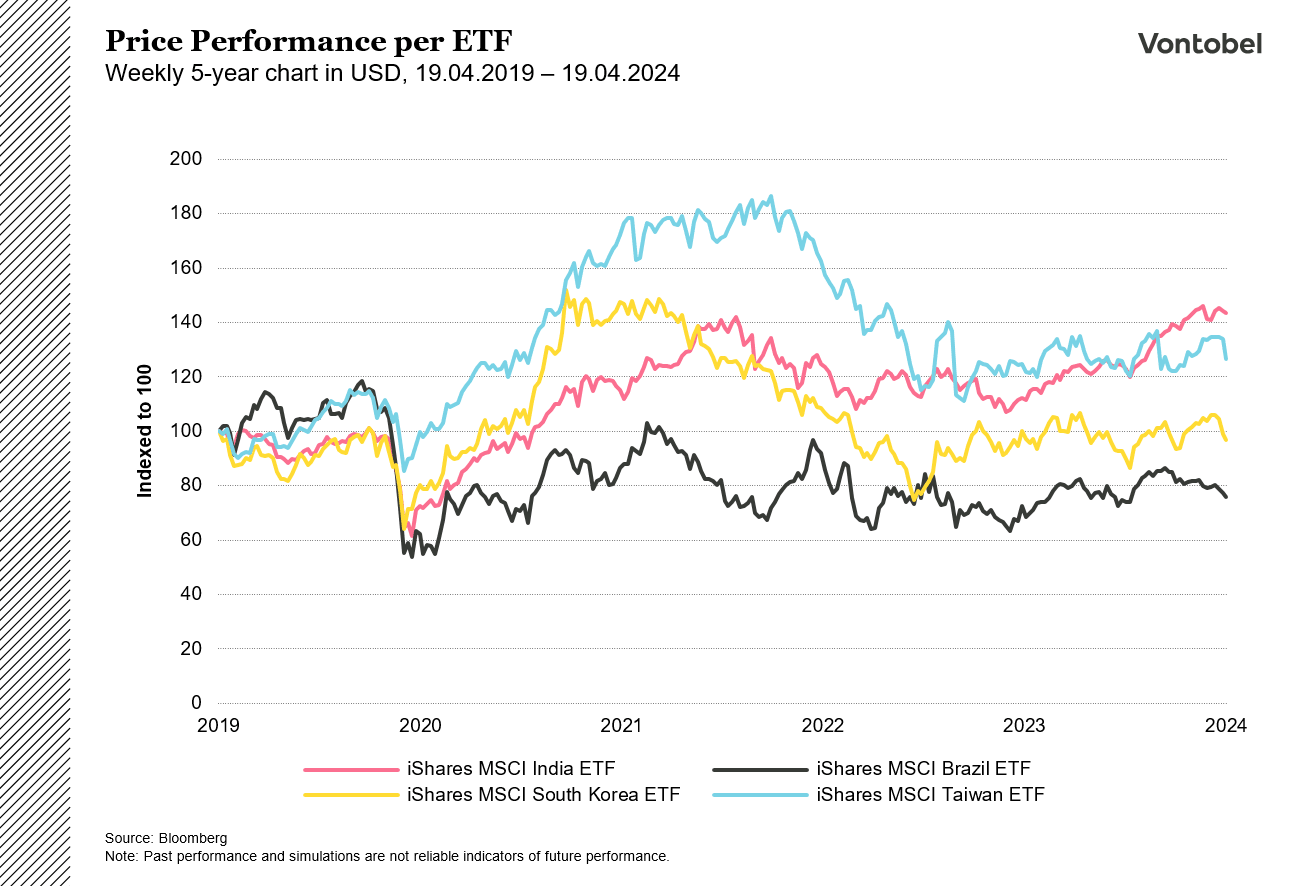Leverage and diversified investments: We are launching Mini Futures on ETFs

Leverage and diversified investments: isn't that an oxymoron? Vontobel recently started offering leveraged products on ETFs. But why take the "detour" via a leveraged product instead of investing directly in an ETF? And which ETFs does Vontobel actually offer as an underlying?
What is an ETF?
The abbreviation ETF stands for Exchange Traded Fund. The purpose of ETFs was and is to replicate the performance of certain indices. There are now a large number of ETFs with different underlying indices/assets. This is also reflected in the growth of the number of ETFs from 450 in 2005 to over 9 500 today.
As the name suggests, ETFs are traded on the stock exchange, which is the major advantage of ETFs over regular funds.
A large number of ETFs are available to fulfil individual investment objectives. This makes it possible to invest in specific asset classes such as shares, bonds or commodities.
In addition, ETFs also offer the possibility to invest specifically in certain sectors, regions and countries, such as in 'mature' or emerging markets, as well as in Europe or the rest of the world.
ETFs are currently enjoying great popularity. For many retail investors, they have become synonymous with passive investment. Passive investing involves following entire markets, sectors or industries in a portfolio rather than actively selecting individual securities, which reduces the burden on the investor.
The generally lower fees compared to actively managed funds also contribute to their popularity. This is because an ETF usually does not have a fund manager who actively tries to outperform a benchmark, and charges for the effort.
However, the performance of many actively managed funds is often below the benchmark after deducting costs. For example, an analysis by index provider S&P Global found that 98% of all euro-denominated global equity funds underperformed the S&P Global 1200® over 10 years.
Invest in different sectors or countries with just one investment
A major advantage of ETFs is that you can cover a particular theme or region with a single investment.
India - the new China?
India is currently considered by many to be the 'new China'. With around 1.4 billion inhabitants, India has already overtaken China as the world's most populous country. Now India wants to overtake China in the technology supply chain. The growth potential in this area is estimated by analysts at 21 per cent per year. The opportunities for India are good because of the political uncertainty. Moreover, an increasing number of technology companies no longer want to rely solely on China as a supplier due to the political risks.
However, it is not only the technology industry that is said to be responsible for India's growth: in recent years, Indian Prime Minister Narendra Modi has initiated far-reaching reforms to modernise his country. The 'Made in India' campaign aims to facilitate investment, promote innovation and establish an internationally competitive production infrastructure in the country. Over the past ten years, India's gross domestic product (GDP) has grown by an average of more than 5.7 per cent per year. Only in the coronavirus year 2020 was the trend negative. GDP is even expected to grow by more than six per cent per year until 2028. The low average age of 28.2 years, which is about ten years lower than in China, is hopeful and a good prerequisite, but no guarantee for the projected growth prospects. However, much of the hope is probably already priced into the Indian stock market. The price-to-earnings (P/E) of the iShares MSCI India ETF is 31.37.
With its 136 holdings, the iShares MSCI India UCITS ETF offers access to the largest and most traded companies in the Indian stock market.

Vontobel now offers Mini Futures on several different ETFs!
We have recently launched Mini Futures, which track ETFs with MSCI India, South Korea, Brazil and Taiwan as their underlying indices. Our products make it possible to participate disproportionately in both the ups and downs of the ETFs. You can learn more about how Mini Futures work here.
We currently have Mini Futures on these ETFs:
- iShares MSCI India ETF
- iShares MSCI Brazil ETF
- iShares MSCI South Korea ETF
- iShares MSCI Taiwan ETF
You will find the products HERE.

But why buy Mini Futures that track an ETF?
Compared to a direct investment in an ETF, an investment in a Mini Future requires a lower capital investment. The resulting leverage allows a disproportionate participation in the performance of the underlying asset. So if you are really convinced, you can participate more strongly in the price development of the corresponding ETF with a leveraged product than with a direct investment.
In addition, a Mini Future Long (MFL) can be used to bet on rising prices and Mini Future Short (MFS) on falling prices.
To summarise, leveraged ETF products provide investors with a new, wide range of products with which individual strategies and objectives can be implemented even more effectively.
Risks
Disclaimer:
This information is neither an investment advice nor an investment or investment strategy recommendation, but advertisement. The complete information on the trading products (securities) mentioned herein, in particular the structure and risks associated with an investment, are described in the base prospectus, together with any supplements, as well as the final terms. The base prospectus and final terms constitute the solely binding sales documents for the securities and are available under the product links. It is recommended that potential investors read these documents before making any investment decision. The documents and the key information document are published on the website of the issuer, Vontobel Financial Products GmbH, Bockenheimer Landstrasse 24, 60323 Frankfurt am Main, Germany, on prospectus.vontobel.com and are available from the issuer free of charge. The approval of the prospectus should not be understood as an endorsement of the securities. The securities are products that are not simple and may be difficult to understand. This information includes or relates to figures of past performance. Past performance is not a reliable indicator of future performance.
© Bank Vontobel Europe AG and/or its affiliates. All rights reserved.
Credit risk of the issuer:
Investors in the products are exposed to the risk that the Issuer or the Guarantor may not be able to meet its obligations under the products. A total loss of the invested capital is possible. The products are not subject to any deposit protection.
Market risk:
The value of the products can fall significantly below the purchase price due to changes in market factors, especially if the value of the underlying asset falls. The products are not capital-protected
Risk with leverage products:
Due to the leverage effect, there is an increased risk of loss (risk of total loss) with leverage products, e.g. Bull & Bear Certificates, Warrants and Mini Futures.
Product costs:
Product and possible financing costs reduce the value of the products.
Currency risk:
If the product currency differs from the currency of the underlying asset, the value of a product will also depend on the exchange rate between the respective currencies. As a result, the value of a product can fluctuate significantly.
